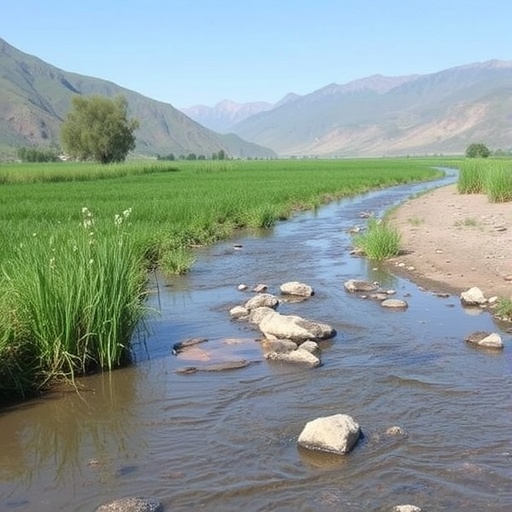In a comprehensive study conducted by a team led by Shoergashova et al., the intricate relationship between agricultural practices, runoff, nutrient loads, and water quality in the Zarafshan River Basin has been meticulously assessed. This research is pivotal considering the fact that the world’s waterways are increasingly burdened by anthropogenic activities, particularly agriculture. The findings underscore the urgent need for sustainable farming practices to mitigate adverse environmental impacts.
The Zarafshan River Basin, a vital watercourse in Central Asia, serves as an important lifeline for local agricultural activities. Its waters are predominantly utilized for irrigation, which has historically contributed to economic development in the region. However, the researchers have drawn attention to a double-edged sword: while agriculture boosts productivity, it also generates significant runoff, containing harmful nutrients that compromise water quality. This duality highlights the fragility of aquatic ecosystems, which are struggling to adapt to the influx of pollutants that modern agricultural practices introduce.
The study’s methodology involved a detailed examination of nutrient loading within different sectors of the basin, particularly focusing on nitrogen and phosphorus concentrations, which are notorious for their role in eutrophication. By employing advanced modeling techniques alongside field observations, the researchers were able to pinpoint the principal sources of these nutrients and their correlation with agricultural runoff. The approach facilitated a deeper understanding of how cultivated lands, characterized by intense fertilizer usage, contribute to the degradation of water quality in local rivers and streams.
Moreover, the researchers employed a multifaceted assessment, taking into consideration various agricultural practices, seasonal variations, and climatic conditions. By analyzing the temporal aspect of nutrient runoff, the study unveiled how seasonal rainfall patterns and irrigation cycles influence nutrient levels in the Zarafshan River. The complexity of this interaction is evident, as the researchers noted that during the rainy season, the potential for nutrient loss increases significantly, compounding the already delicate balance of water quality in the river basin.
The implications of these findings are far-reaching. The study warns that unchecked agricultural runoff could have significant repercussions not only for local ecosystems but also for human health as communities rely on this water for drinking and sanitation. Furthermore, the economic ramifications are also pronounced; as water quality decreases, it can threaten food security and agricultural productivity, leading to a cycle of poverty and resource scarcity in the region.
In crafting effective policy solutions, the researchers emphasize the importance of adopting best management practices (BMPs) in agriculture, which could significantly reduce nutrient leaching. Implementing techniques such as riparian buffers, cover cropping, and precision agriculture can help maintain the functional integrity of the Zarafshan River while continuing to support its agricultural output. The study advocates for a collaborative approach involving local farmers, water management authorities, and environmental agencies to develop targeted strategies tailored to the specific needs of the basin.
Through their findings, Shoergashova et al. contribute to a growing body of literature that underscores the urgency of addressing agricultural impacts on freshwater ecosystems globally. This research serves as a clarion call to stakeholders in the agricultural sector to recognize their pivotal role in environmental stewardship. It also highlights the necessity for further studies aimed at evaluating the long-term effects of agricultural practices on water quality, effectiveness of remedial actions, and ultimately, the health of our planet’s freshwater resources.
In conclusion, the study encapsulates a critical balance between agricultural productivity and environmental sustainability. As the pressures on water quality escalate, it becomes imperative for farmers to adopt practices that harmonize with the ecological systems around them, ensuring that future generations inherit a healthy and resilient natural resource base. The insights gleaned from the Zarafshan River Basin serve as a microcosm of global challenges faced in water management, reinforcing the idea that the path forward must be paved with innovation, cooperation, and commitment to sustainability.
This research not only emphasizes the need for immediate actions to mitigate the impact of agricultural runoff but also invites broader discussions about the future of agriculture in the face of climate change. Addressing these complex challenges requires an integrated approach to water quality management that spans across disciplines and sectors, ensuring water security for both the environment and human populations.
In the end, the assessment of agriculture’s impact on nutrient load and water quality presents an avenue for substantial improvement and offers a framework from which the agricultural community can glean valuable lessons. As the findings resonate through the scientific and agricultural community, they reinforce the necessity for continued research and action plans aimed at sustaining the health of our vital water resources in an ever-evolving agricultural landscape.
Subject of Research: Impacts of agriculture and runoff on water quality in the Zarafshan River Basin.
Article Title: Assessment of agriculture and potential runoff impacts on nutrient load and water quality in the Zarafshan River Basin.
Article References: Shoergashova, S., Liu, T., Wang, W. et al. Assessment of agriculture and potential runoff impacts on nutrient load and water quality in the Zarafshan River Basin. Environ Monit Assess 197, 1377 (2025). https://doi.org/10.1007/s10661-025-14827-4
Image Credits: AI Generated
DOI: https://doi.org/10.1007/s10661-025-14827-4
Keywords: nutrient load, water quality, agriculture, runoff, Zarafshan River, sustainable farming practices, environmental impacts, Central Asia.




